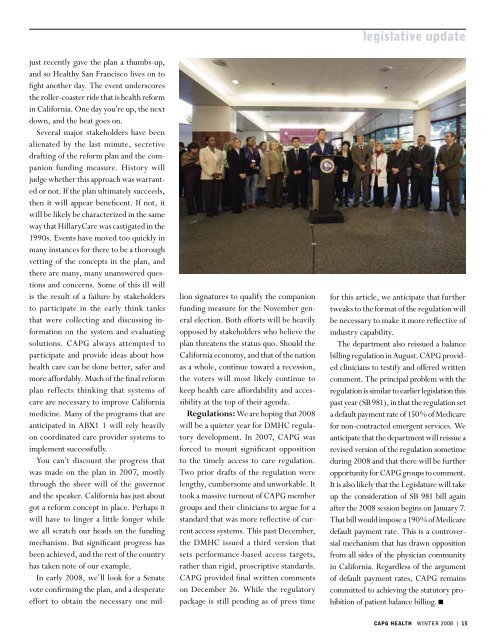Update on Health Care Reform
Update on Health Care Reform
Update on Health Care Reform
Create successful ePaper yourself
Turn your PDF publications into a flip-book with our unique Google optimized e-Paper software.
just recently gave the plan a thumbs-up,<br />
and so <strong>Health</strong>y San Francisco lives <strong>on</strong> to<br />
fight another day. The event underscores<br />
the roller-coaster ride that is health reform<br />
in California. One day you’re up, the next<br />
down, and the beat goes <strong>on</strong>.<br />
Several major stakeholders have been<br />
alienated by the last minute, secretive<br />
drafting of the reform plan and the compani<strong>on</strong><br />
funding measure. History will<br />
judge whether this approach was warranted<br />
or not. If the plan ultimately succeeds,<br />
then it will appear beneficent. If not, it<br />
will be likely be characterized in the same<br />
way that Hillary<strong>Care</strong> was castigated in the<br />
1990s. Events have moved too quickly in<br />
many instances for there to be a thorough<br />
vetting of the c<strong>on</strong>cepts in the plan, and<br />
there are many, many unanswered questi<strong>on</strong>s<br />
and c<strong>on</strong>cerns. Some of this ill will<br />
is the result of a failure by stakeholders<br />
to participate in the early think tanks<br />
that were collecting and discussing informati<strong>on</strong><br />
<strong>on</strong> the system and evaluating<br />
soluti<strong>on</strong>s. CAPG always attempted to<br />
participate and provide ideas about how<br />
health care can be d<strong>on</strong>e better, safer and<br />
more affordably. Much of the final reform<br />
plan reflects thinking that systems of<br />
care are necessary to improve California<br />
medicine. Many of the programs that are<br />
anticipated in ABX1 1 will rely heavily<br />
<strong>on</strong> coordinated care provider systems to<br />
implement successfully.<br />
You can’t discount the progress that<br />
was made <strong>on</strong> the plan in 2007, mostly<br />
through the sheer will of the governor<br />
and the speaker. California has just about<br />
got a reform c<strong>on</strong>cept in place. Perhaps it<br />
will have to linger a little l<strong>on</strong>ger while<br />
we all scratch our heads <strong>on</strong> the funding<br />
mechanism. But significant progress has<br />
been achieved, and the rest of the country<br />
has taken note of our example.<br />
In early 2008, we’ll look for a Senate<br />
vote c<strong>on</strong>firming the plan, and a desperate<br />
effort to obtain the necessary <strong>on</strong>e mil-<br />
li<strong>on</strong> signatures to qualify the compani<strong>on</strong><br />
funding measure for the November general<br />
electi<strong>on</strong>. Both efforts will be heavily<br />
opposed by stakeholders who believe the<br />
plan threatens the status quo. Should the<br />
California ec<strong>on</strong>omy, and that of the nati<strong>on</strong><br />
as a whole, c<strong>on</strong>tinue toward a recessi<strong>on</strong>,<br />
the voters will most likely c<strong>on</strong>tinue to<br />
keep health care affordability and accessibility<br />
at the top of their agenda.<br />
Regulati<strong>on</strong>s: We are hoping that 2008<br />
will be a quieter year for DMHC regulatory<br />
development. In 2007, CAPG was<br />
forced to mount significant oppositi<strong>on</strong><br />
to the timely access to care regulati<strong>on</strong>.<br />
Two prior drafts of the regulati<strong>on</strong> were<br />
lengthy, cumbersome and unworkable. It<br />
took a massive turnout of CAPG member<br />
groups and their clinicians to argue for a<br />
standard that was more reflective of current<br />
access systems. This past December,<br />
the DMHC issued a third versi<strong>on</strong> that<br />
sets performance-based access targets,<br />
rather than rigid, proscriptive standards.<br />
CAPG provided final written comments<br />
<strong>on</strong> December 26. While the regulatory<br />
package is still pending as of press time<br />
legislative update<br />
for this article, we anticipate that further<br />
tweaks to the format of the regulati<strong>on</strong> will<br />
be necessary to make it more reflective of<br />
industry capability.<br />
The department also reissued a balance<br />
billing regulati<strong>on</strong> in August. CAPG provided<br />
clinicians to testify and offered written<br />
comment. The principal problem with the<br />
regulati<strong>on</strong> is similar to earlier legislati<strong>on</strong> this<br />
past year (SB 981), in that the regulati<strong>on</strong> set<br />
a default payment rate of 150% of Medicare<br />
for n<strong>on</strong>-c<strong>on</strong>tracted emergent services. We<br />
anticipate that the department will reissue a<br />
revised versi<strong>on</strong> of the regulati<strong>on</strong> sometime<br />
during 2008 and that there will be further<br />
opportunity for CAPG groups to comment.<br />
It is also likely that the Legislature will take<br />
up the c<strong>on</strong>siderati<strong>on</strong> of SB 981 bill again<br />
after the 2008 sessi<strong>on</strong> begins <strong>on</strong> January 7.<br />
That bill would impose a 190% of Medicare<br />
default payment rate. This is a c<strong>on</strong>troversial<br />
mechanism that has drawn oppositi<strong>on</strong><br />
from all sides of the physician community<br />
in California. Regardless of the argument<br />
of default payment rates, CAPG remains<br />
committed to achieving the statutory prohibiti<strong>on</strong><br />
of patient balance billing. ■<br />
CAPG HEALTH WINTER 2008 | 15


